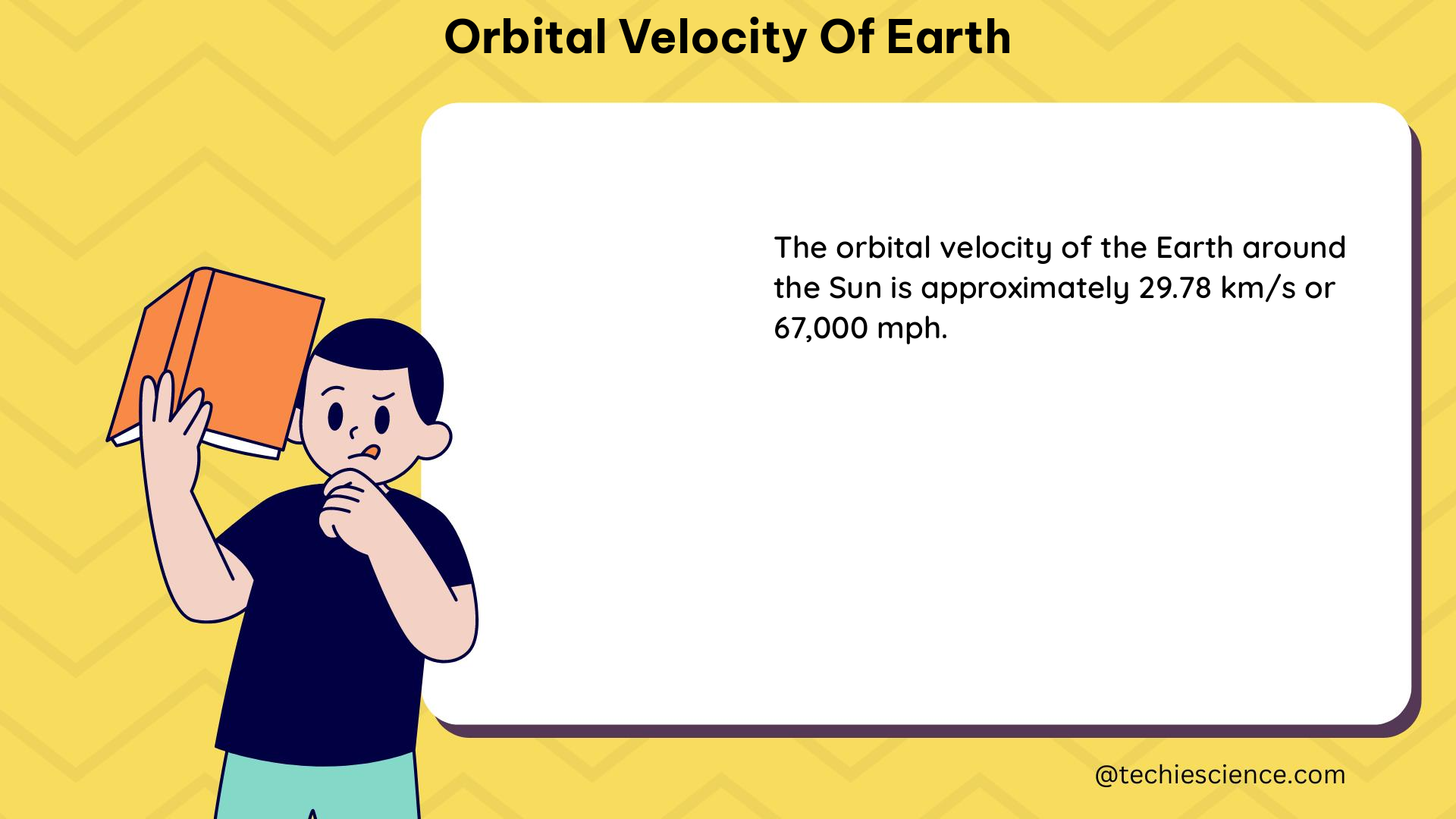The orbital velocity of Earth, which is the speed at which it orbits around the Sun, is a fundamental concept in celestial mechanics and astrophysics. This velocity is determined by the balance between the gravitational force exerted by the Sun and the centrifugal force acting on the Earth as it revolves around the Sun. Understanding the precise calculation and factors influencing the orbital velocity of Earth is crucial for various applications, including satellite tracking, space exploration, and the study of planetary dynamics.
Understanding the Circular Orbit Velocity Formula
The orbital velocity of Earth can be calculated using the formula for circular orbit velocity, which is derived from the principles of classical mechanics:
v = √(GM/r)
Where:
– v is the orbital velocity of the object (in this case, the Earth)
– G is the gravitational constant, with a value of approximately 6.67 × 10^-11 N⋅m^2/kg^2
– M is the mass of the body being orbited (in this case, the Sun), which is approximately 2.0 × 10^30 kg
– r is the distance from the center of the body being orbited (in this case, the average distance from the Sun to the Earth, which is approximately 1.50 × 10^11 m
Calculating the Orbital Velocity of Earth

Substituting the values into the formula, we can calculate the orbital velocity of Earth as follows:
v = √[(6.67 × 10^-11 N⋅m^2/kg^2) × (2.0 × 10^30 kg) / (1.50 × 10^11 m)]
v = 3.0 × 10^4 m/s
Therefore, the orbital velocity of Earth is approximately 30 km/s or 18,600 miles per hour.
Factors Affecting the Orbital Velocity of Earth
-
Elliptical Orbit: The Earth’s orbit around the Sun is not perfectly circular, but rather elliptical. This means that the Earth’s distance from the Sun varies throughout its orbit, which in turn affects its orbital velocity. At the closest point to the Sun (perihelion), the Earth’s orbital velocity is slightly higher at around 30.29 km/s, while at the farthest point (aphelion), it is slightly lower at around 29.29 km/s.
-
Gravitational Influences: The gravitational pull of other celestial bodies, such as the Moon and the other planets in the solar system, can also affect the Earth’s orbital velocity and path. These gravitational forces can cause slight variations in the Earth’s orbital velocity and trajectory, which can have significant effects on Earth’s climate and weather patterns over long periods of time.
-
Orbital Eccentricity: The eccentricity of the Earth’s orbit, which is a measure of how elliptical the orbit is, also plays a role in determining the orbital velocity. The more eccentric the orbit, the greater the variation in the Earth’s distance from the Sun and, consequently, the greater the variation in its orbital velocity.
-
Conservation of Angular Momentum: The principle of conservation of angular momentum states that the product of an object’s mass, distance from the center of rotation, and velocity must remain constant. As the Earth’s distance from the Sun varies throughout its orbit, its velocity must adjust accordingly to maintain a constant angular momentum.
Practical Applications of Orbital Velocity
The precise calculation and understanding of the Earth’s orbital velocity have numerous practical applications, including:
-
Satellite Tracking and Positioning: Knowing the Earth’s orbital velocity is crucial for accurately tracking and positioning satellites orbiting the Earth, as well as for predicting their trajectories and maintaining their orbits.
-
Space Exploration: The orbital velocity of Earth is a key factor in planning and executing space missions, as it determines the energy required to launch spacecraft and the timing of launch windows.
-
Celestial Mechanics: The study of the Earth’s orbital velocity, along with the velocities of other celestial bodies, is fundamental to the field of celestial mechanics, which aims to understand the dynamics of the solar system and the universe.
-
Climate and Weather Modeling: The variations in the Earth’s orbital velocity, caused by the gravitational influences of other bodies, can have significant effects on the planet’s climate and weather patterns over long timescales.
Conclusion
The orbital velocity of Earth is a crucial concept in physics and astrophysics, with numerous practical applications. By understanding the formula for circular orbit velocity and the factors that influence the Earth’s orbital velocity, we can gain valuable insights into the dynamics of the solar system and the universe as a whole.
References:
- Science Ready. (n.d.). Orbital Velocity. Retrieved from https://scienceready.com.au/pages/orbital-velocity
- American Museum of Natural History. (2000). COSMIC HORIZONS: ASTRONOMY AT THE CUTTING EDGE. Retrieved from https://www.amnh.org/learn-teach/curriculum-collections/cosmic-horizons-book/ole-roemer-speed-of-light
- Wikipedia. (2023, May 24). Rømer’s determination of the speed of light. Retrieved from https://en.wikipedia.org/wiki/R%C3%B8mer%27s_determination_of_the_speed_of_light
- Perfdrive. (2021, June 22). Primary Velocity and Orbital Phase Effects on Planetary Detectability. Retrieved from https://hcvalidate.perfdrive.com/fb803c746e9148689b3984a31fccd902/?ssa=fb1eb63f-787b-4e38-a0b1-4892be0b85c1&ssb=97551206772&ssc=https%3A%2F%2Fiopscience.iop.org%2Farticle%2F10.3847%2F1538-3881%2Fabf7b9&ssi=643a5a14-8427-4932-8126-20ae3247b718&ssk=support%40shieldsquare.com&ssm=76617299275921433106261921113189&ssn=d565c17de7720365a750713033ee67bd9c1a8df34431-6e69-4fbd-88556d&sso=5fcd7465-982efdd7251bb5b4d332074e9ced32278bf886f79d555db2&ssp=25048713511713859290171387977950908&ssq=15222857993826193555479938260008755205644&ssr=MTg1LjEzNS4yMTIuMjIz&sst=Mozilla%2F5.0+%28Macintosh%3B+Intel+Mac+OS+X+10_15_7%29+AppleWebKit%2F605.1.15+%28KHTML%2C+like+Gecko%29+Version%2F16.6+Safari%2F605.1.15&ssx=W10%3D
- The Physics Classroom. (n.d.). Mathematics of Satellite Motion. Retrieved from https://www.physicsclassroom.com/class/circles/Lesson-4/Mathematics-of-Satellite-Motion

The lambdageeks.com Core SME Team is a group of experienced subject matter experts from diverse scientific and technical fields including Physics, Chemistry, Technology,Electronics & Electrical Engineering, Automotive, Mechanical Engineering. Our team collaborates to create high-quality, well-researched articles on a wide range of science and technology topics for the lambdageeks.com website.
All Our Senior SME are having more than 7 Years of experience in the respective fields . They are either Working Industry Professionals or assocaited With different Universities. Refer Our Authors Page to get to know About our Core SMEs.